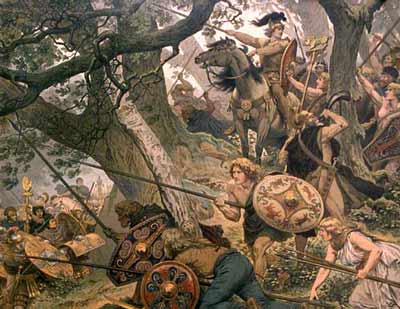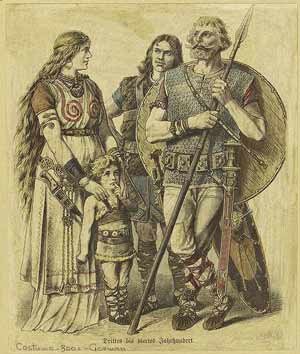
The Battle of the Teutoburg Forest
Neil Faulkner Archive | ETOL Main Page
Marxist History
Published online by Counterfire, 24 October 2010.
Copied with thanks from the Counterfire Website.
Marked up by Einde O’Callaghan for the Encyclopaedia of Trotskyism On-Line (ETOL).
Neil Faulkner explains how the Roman Empire entered its terminal crisis as its military imperialism came up against geographical, economic, and sociological barriers to expansion.

The Battle of the Teutoburg Forest |
The Roman Empire represented a powerful fusion of citizenship and imperialism.
Citizenship provided an expanding social base of stakeholders and soldiers. Conquered elites were slowly assimilated and acculturised. They were allowed to become ‘Roman’ and share in the benefits of Roman imperial rule.
Imperialism provided a continual flow of booty, slaves, and land. This strengthened the state, enriched the ruling class, secured the allegiance of subject elites, and funded programmes of patronage which bound client groups to the system.
But there was a heavy price. Empire and civilisation are expensive. While some benefit, others lose. Roman rule safeguarded property, privilege, and power. But the wealth of the army, the towns, and the villa-owners rested upon a system of exploitation by which taxes, rents, interest-payments, and labour-services were extracted from the rural population.
The majority of the inhabitants of the Roman Empire worked on the land as peasants, labourers, serfs, and slaves. They were the beasts of burden on whose backs empire and civilisation were built.
At first, the burden – the rate of exploitation – was relatively moderate and sustainable. Much was taken, but enough was left to enable peasant families to feed themselves, to re-seed their fields and re-stock their pastures, and to barter for the everyday essentials of Iron Age rural life in local markets.
This was possible because others paid a much heavier price. The Empire was subsidised by wars of conquest. The defeated were robbed to enrich the victors. The victims of imperialism paid the bulk of the cost of the supporting the state, the army, and the rich. As long as the Empire continued to expand, robbery at home was moderated by robbery abroad.
The system was inherently expansionist. It was fed by the military appropriation of foreign surpluses. Its vitality therefore depended on the continuing availability of such surpluses. After each imperial leap, another was immediately necessary if the system was not to face stagnation and crisis.
But foreign surpluses were, of course, a finite resource. By the 1st century CE (common era), Roman military imperialism was running up against geographical, economic, and sociological barriers to expansion. The limits of Graeco-Roman imperial civilisation corresponded with the limits of Iron Age agriculture.
Iron Age technology had created an extensive zone of plough-based agriculture stretching from Southern Britain to Syria, from the Rhine and the Danube in Europe to the Atlas Mountains of North Africa. This was a fat land, full of fields, villages, and hard-working peasants. Surpluses were high. Those who organised themselves to take the surpluses by force could build armies, cities, and palaces.
But beyond the ploughland lay wilderness: the hills of Northern Britain, the forests of Germany, the deserts of Arabia and North Africa. When imperial armies tramped into the wilderness, they found themselves bogged down in unwinnable guerrilla wars against scattered and elusive opponents who were too impoverished to yield a profit even if they could be caught.
In 53 BCE (before the common era), a Roman army of 30,000 had been destroyed by Parthian horse-archers at the Battle of Carrhae in Syria. In 9 CE, another Roman army of 30,000 was annihilated by German tribesmen at the Battle of the Teutoburg Forest.
In 208-211 CE, the final Roman attempt to conquer Northern Britain was defeated by guerrilla resistance. ‘Let no-one escape utter destruction at our hands,’ was the chilling injunction of the Roman emperor Septimius Severus to his men. ‘Let not the infant still carried in its mother’s womb, if it be male, escape from its fate.’
 Septimius Severus, the brutal Roman emperor |
But they did escape. Severus died at York, and Scotland was never conquered. In the bogs and glens of the British North, the imperial leviathan, lashing out into the mist and drizzle, was reduced to despair by bands of blue-painted skirmishers.
The Roman Empire had limits. Its foundation-block was Iron Age agriculture. It depended upon cultivated land and abundant labour to yield the large surpluses necessary to support the army, the ruling class, and the essential infrastructure of roads, forts, and towns. War was profitable where the plough ruled. War was a drain, and the empire became over-extended, when armies entered the wilderness.
Expansion peaked in the 2nd and 1st centuries BCE. It slowed sharply after the early 1st century CE, and ceased almost entirely after the early 2nd century CE. The flow of war booty was cut off. External subsidy ceased. The Roman Empire became entirely dependent on internally-generated resources.
Yet the cost of empire and civilisation did not diminish. A strong army and a thick belt of fortifications were required to defend thousands of miles of open frontier. Internal stability depended upon high levels of luxury consumption and imperial patronage.
From the 1st century CE onwards, and with increasing intensity, especially from the late 2nd century CE, the imperial state faced chronic financial crisis. The state’s response – increased agrarian surplus-extraction to maintain its politico-military infrastructure – generated a slowly-revolving spiral of economic decline.
Increases in taxation, forced labour, and military requisitioning pushed the marginal farms of poor peasants into ruin. This shrank the tax-base, such that, in the next round, taxes would have to be jacked up even further, pushing another tranche of farms over the edge. And so on.
The Late Roman imperial state, increasingly militarised and totalitarian, consumed its own socio-economic base in its efforts to maintain essential expenditure. The military predator had become a cannibal.
The pressures had three main political effects. First, the ruling class repeatedly split into regional fragments, each group attempting to retain control of its own surpluses and soldiers. Civil wars, usually between army factions led by rival emperors in different parts of the empire, became endemic.
 The defences of the Roman Empire frequently |
Second, foreign invasions became frequent and increasingly dangerous. On the European frontiers, they involved large ‘barbarian’ tribal confederations, and in the East, the dynamic Sassanian Empire, based in Iran and Iraq.
Rome’s military decline is symbolised by two battles. At the Battle of Adrianople in 378 CE, the entire field army of the Eastern Roman Empire was destroyed by the Goths. Sixteen years later, at the Battle of the River Frigidus in 394 CE, the bulk of the army of the Eastern Roman Empire was formed of Gothic mercenaries. Such was the internal crisis of finance and manpower that the Roman Empire had become dependent on ‘barbarian’ soldiers.
The third effect of the crisis was an upsurge in class struggle. The local peasantry, squeezed by the demands of the military-bureaucratic complex, reduced to serf status and subject to ever-rising levels of exploitation, found ways to fight back.
Many farms were abandoned. Social banditry became endemic in much of the countryside. Resistance to tax-collectors, press-gangs, and bailiffs was widespread. And sometimes, discontent swelled into peasant insurrection and the creation of rural communes.
Ancient aristocratic writers speak of the bagaudae. Apparently, under the rule of the bagaudae, people lived by popular laws, peasants made speeches, capital sentences were pronounced under an oak tree and recorded on bones, and ‘anything goes’. Apparently, under the bagaudae, ‘the Bretons were slaves of their own domestics’.
Here, it seems, dimly understood and darkly described, we have a world turned upside down: a world without landlords, tax-collectors, and police.
As the Roman Empire entered its terminal crisis, as its foreign enemies broke in and its rulers turned on one another in blame and bitterness, its long-suffering victims found the space to organise themselves, take courage, and fight back.
History’s three engines – cultural progress, competition between rulers, and the class struggle – were in top gear. A new world order was being forged in the fire-storms of Late Antiquity.
Neil Faulkner Archive | ETOL Main Page
Eleven Reasons to Fight
Last updated on: 14 February 2022